What is the meaning of CTV advertising?
A type of digital advertising that uses Connected TV (CTV) devices, such as smart TVs, to deliver targeted video ads
Connected TV (CTV) has become an increasingly popular way for people to consume their favorite TV shows and movies. With the rise of CTV comes new opportunities for advertisers to reach their target audiences through CTV advertising. As CTV becomes a more integral part of the media landscape, understanding CTV advertising is essential for any marketer looking to reach their target audience through digital advertising channels.
CTV advertising works by using the internet to deliver video content to viewers via streaming devices such as smart TVs, gaming consoles, and media streaming players. Advertisers can create targeted ads and display them on these devices during streaming content, allowing them to reach a specific audience with relevant messaging. CTV advertising is typically delivered through programmatic advertising platforms, which allow advertisers to buy ad inventory in real-time based on factors such as demographics, geography, and interests.
As connected TVs continue to advance, more tools will be available to digital advertisers. Who knows if in the near future advertisers can play around with voice or face recognition, eye-tracking, or even clickable ads on TV.
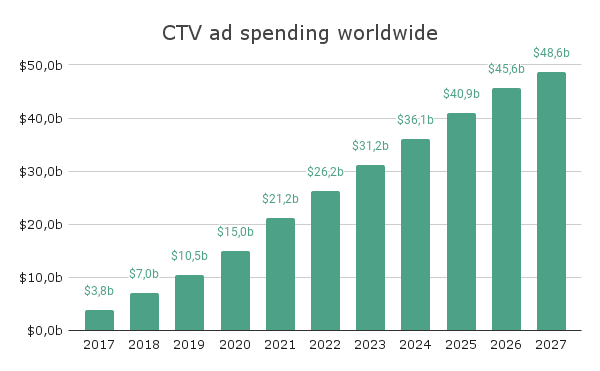
Source: Statista. (June 22, 2022). Connected TV (CTV) advertising spending worldwide from 2017 to 2027 (in billion U.S. dollars) [Graph]. In Statista.
“As connected TVs continue to advance, more tools will be available to digital advertisers. Who knows if in the near future advertisers can play around with voice or face recognition, eye-tracking, or even clickable ads on TV”
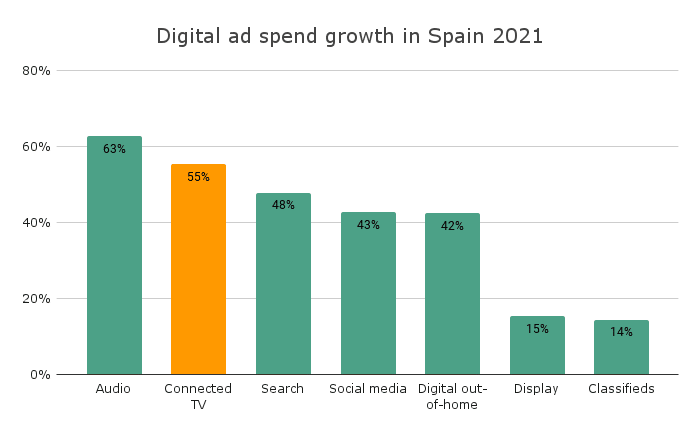
Source: IAB Spain, & PwC. (February 26, 2022). Change in digital advertising spending in Spain in 2021, by format [Graph]. In Statista.
How can CTV advertisers benefit and drive more leads?
There are several benefits of CTV (connected TV) advertising, which is why it has become an increasingly popular form of digital advertising. Here are some of the key benefits:
1. Targeted Ads:
CTV advertising allows for more precise targeting of viewers based on demographics, location, and interests, among other factors. This allows advertisers to reach their intended audience more effectively, resulting in higher engagement and conversion rates.
2. High completion rates:
CTV advertising typically has high completion rates compared to other forms of digital advertising. This is because CTV ads are served in a non-intrusive way, often during natural breaks in content or before and after the program. As a result, viewers are more likely to watch the entire ad or at least a significant portion of it. There are also measures in place to ensure that ads are not skippable
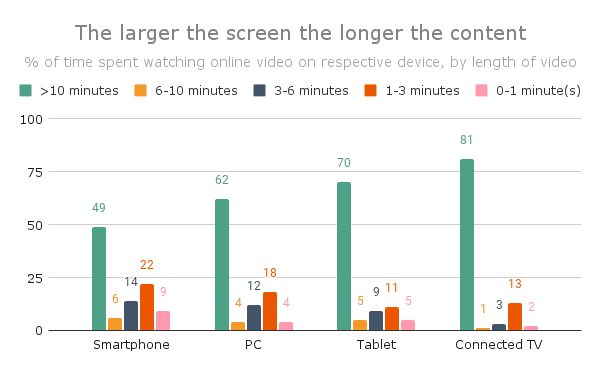
Source: Richter, F. The Larger the Screen the Longer the Content?. In Statista.
3. Larger Screen Sizes:
CTV advertising is displayed on larger screens than mobile or desktop ads, providing a more immersive experience for viewers. This can lead to higher engagement rates and better recall of the ad. One example of this is how consumers spend more time watching longer forms of video on Connected TVs vs other devices such as smartphones, PCs, and tablets.
4. Less Ad Fatigue:
CTV viewers are typically exposed to fewer ads than viewers of traditional linear TV, which can lead to less ad fatigue and a more positive viewing experience.
5. Better Tracking and Analytics:
CTV advertising allows for more accurate tracking and analytics than traditional TV advertising. Advertisers can measure ad viewability, completion rates, and engagement metrics, among other things, allowing for more effective optimization of ad campaigns.
6. Flexibility and Customization:
CTV advertising provides advertisers with more flexibility and customization options than traditional TV advertising. Advertisers can choose from a range of ad formats and targeting options, and can also run programmatic ad campaigns, allowing for real-time bidding and optimization.
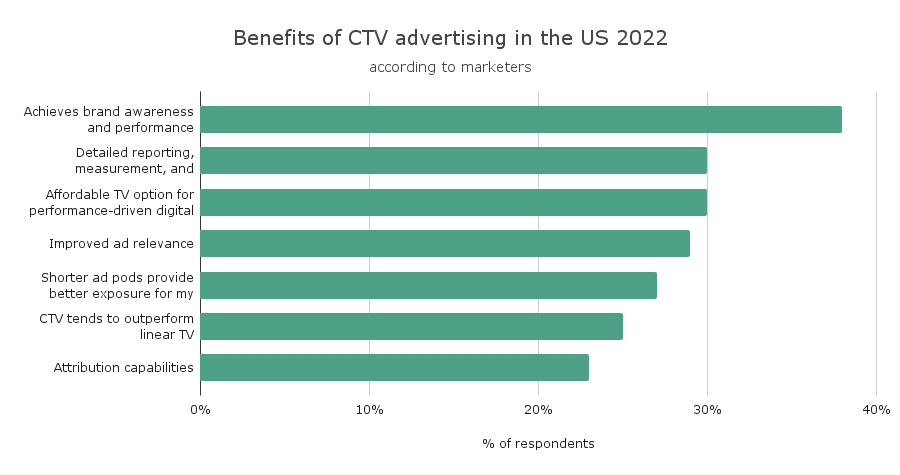
Source: Premion. (July 25, 2022). Leading performance- and pricing-related benefits of connected TV and over-the-top advertising according to marketers in the United States in March 2022 [Graph]. In Statista.
What are CTV advertising examples?
There are many different types of CTV advertising, and advertisers can choose from a range of ad formats and targeting options to reach their desired audience on CTV platforms.Here are some examples of CTV (connected TV) advertising:
1. Pre-Roll Ads: These are video ads that play before a streaming video begins on a CTV device.
2. Mid-Roll Ads: These are video ads that play in the middle of a streaming video on a CTV device.
3. Post-Roll Ads: These are video ads that play after a streaming video has finished on a CTV device.
4. Overlay Ads: These are ads that appear as a banner or pop-up on the screen while a video is playing on a CTV device.
5. Interactive Ads: These are ads that encourage viewers to interact with the ad, such as by clicking on it or using their remote to make choices in an interactive ad experience.
How was Traditional TV advertising adapted with Connected TV?
Inevitably, traditional TV advertising will need to change in order to make the most of CTV. If not, no efficiencies can be enjoyed or worse, more waste will be made as there will be a double count in terms of advertising campaigns.
First, CTV complements traditional tv, or linear tv, by providing incremental reach. This means that brands are reaching an audience that were not reached by linear tv. For now, brands cannot yet fully transition to CTV and drop linear tv altogether.
Second, brands can alter the content of their campaigns to suit the audiences who have CTV who are more highly engaged and affluent. Longer form contents is now a possibility while more expensive products or services can be prioritized.
Lastly, brands can do roll-out content faster and do more test-and-learns. Since tracking and measuring is faster and more accurate with CTV, real-time revisions to the campaign becomes possible. At the same time, real and direct feedback from consumers can be considered into the decision-making process.
As connected TVs continue to advance, more tools will be available to digital advertisers. Who knows if in the near future advertisers can play around with voice or face recognition, eye-tracking, or even clickable ads on TV.
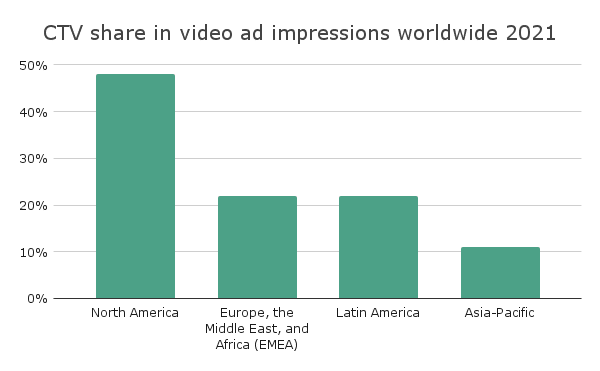
Source: Innovid. (May 11, 2022). Share of connected TV (CTV) in video advertising impressions worldwide in 2021, by region [Graph]. In Statista.
“CTV advertising allows for more precise targeting of viewers that enables advertisers to reach their intended audience more effectively, resulting in higher engagement and conversion rates”
What are some CTV Advertising Platforms?
There are a number of CTV advertising platforms available to advertisers, each with their own strengths and features. Here are some of the most popular platforms:
1. Roku: Roku is one of the most widely used CTV platforms and offers a wide range of advertising options, including pre-roll, mid-roll, and post-roll ads, as well as interactive ads and sponsored content.
2. Amazon Fire TV: Amazon Fire TV is another popular CTV platform that offers a range of advertising options, including display ads, video ads, and custom branded experiences.
3. Hulu: Hulu is a popular streaming service that offers a range of advertising options, including pre-roll, mid-roll, and post-roll ads, as well as sponsored content and interactive ads.
4. YouTube TV: YouTube TV allows advertisers to create custom campaigns that can target specific audiences based on interests and demographics. Ad formats include pre-roll and mid-roll ads, as well as sponsored content.
These are just a few examples of the CTV advertising platforms available to advertisers. Each platform offers its own unique features and strengths, so it’s important to choose the one that best suits your advertising goals and target audience.
What are the challenges of CTV advertising?
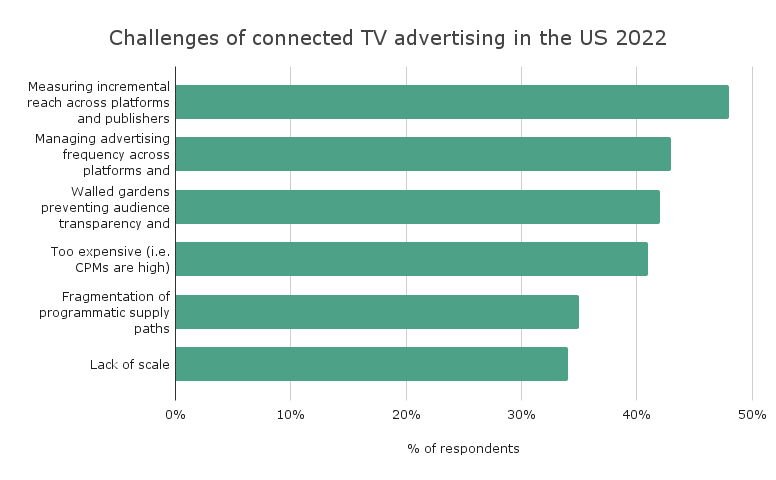
Source: IAB (U.S.). (May 2, 2022). Challenges most likely to impact connected TV (CTV) advertising in the United States as of March 2022 [Graph]. In Statista.
1. Fragmentation:
The CTV landscape is highly fragmented, with a wide range of different platforms, devices, and operating systems. This can make it difficult for advertisers to manage their campaigns across multiple platforms, and can also make it harder to measure and compare ad performance.
2. Limited Inventory:
While CTV viewership is growing rapidly, inventory can be limited on some platforms. This can result in higher ad costs and increased competition for ad placements.
3. Ad Skipping:
CTV viewers may have the ability to skip ads or use ad-blocking technology, which can reduce the effectiveness of ad campaigns.
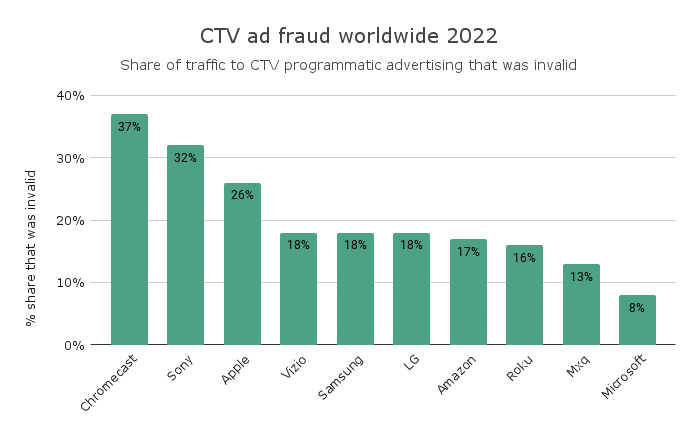
Source: Pixalate. (January 11, 2023). Share of traffic to connected TV (CTV) programmatic advertising that was invalid worldwide in 2nd quarter 2022, by CTV device [Graph]. In Statista.
4. Ad Fraud:
Ad fraud is a concern on CTV, just as it is on other digital advertising channels. Advertisers need to take steps to protect their ad spend from fraudsters who use tactics such as bot traffic, click farms, and fake ad impressions.
5. Measurement and Attribution:
Measuring the effectiveness of CTV ad campaigns can be challenging, particularly in terms of attribution. Advertisers need to be able to track how their ads are driving engagement, conversions, and other key performance indicators across multiple devices and platforms.
While CTV advertising offers a range of benefits for advertisers, it is important to be aware of the challenges and limitations of this channel in order to optimize ad campaigns for maximum effectiveness. Advertisers should work closely with their ad tech partners and media vendors to address these challenges and optimize their CTV ad campaigns for success.
Want to know more about CTV Advertising? Do you want to start advertising on Connected TV already?
Contact Indaru or follow us on linkedin.
Featured Image by rawpixel.com on Freepik




